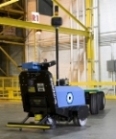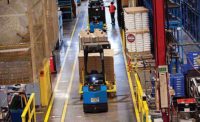
The GT3 is a
vision-guided industrial mobile robot that transports materials and finished
goods with no workflow disruption. Photo courtesy Seegrid Corp.
Manufacturers are always looking for ways to maximize their skilled employees. One way is to free them from lower-valued tasks-such as pulling carts, delivering palletized materials and positioning supplies in tight areas.
Daimler Trucks NA LLC is one such manufacturer that has found a more cost-effective way to complete these tasks: use the GT3 tugger, a vision-guided industrial mobile robot that transports materials and finished goods with no workflow disruption. Made by Seegrid Corp., the GT3 increases productivity by constantly enforcing the work pace.
Donnie Dixon, supervisor of materials control at Daimler, confirms the tugger’s flexibility. “We needed flexibility to be able to change the routes easily and frequently, and the GT3 does that for us,” says Dixon. “We use the GT3 to continually supply parts to our assembly stations. We love its versatility-we are able to simply change and perform multiple routes for our first and second shifts and do a completely different route for our third shift-just that flexibility alone provided us real value.”
The tugger employs Industrial Mobile Robotics (IMR) technology, which enables it to move through manufacturing, warehousing and distribution operations utilizing stereo cameras to build a reliable 3D map of the environment. The tugger then uses the map and its own reasoning ability to navigate a predetermined path to complete its assigned transport task.
IMR technology gives the tugger early-stage autonomous robot behavior with sense, move, analyze, interact and repeat capabilities. These capabilities let the operator simply and easily instruct the robot along a desired path, adding behaviors such as horns and stop stations. The vehicle can be put to work once an operator inputs the transport path.
The tugger has a maximum towing capacity of 3,000 pounds and can move items on surfaces having up to a 5 percent grade. It can learn and store 15 miles of routes. At full load, the tugger can travel 1.7 mph and go from zero to full speed in 3 seconds.
The tugger is powered by three 36-volt, 185 amp/hour batteries, with 415 reserve minutes. A battery discharge indicator signals when the battery is low. The vehicle’s chassis dimensions are 46.5 by 33 by 43.75 inches, not including the camera head.
As for construction, the tugger features self-diagnostic motor controllers, dynamic braking and a heavy-duty, powder-coated steel frame and hood. The vehicle also has nonmarking, foam-filled no-maintenance tires and a split handlebar with twist grips for adjusting the tugger’s speed.
For more information on vision-guided industrial mobile robots, call 877-733-4743 or visit www.seegrid.com.




